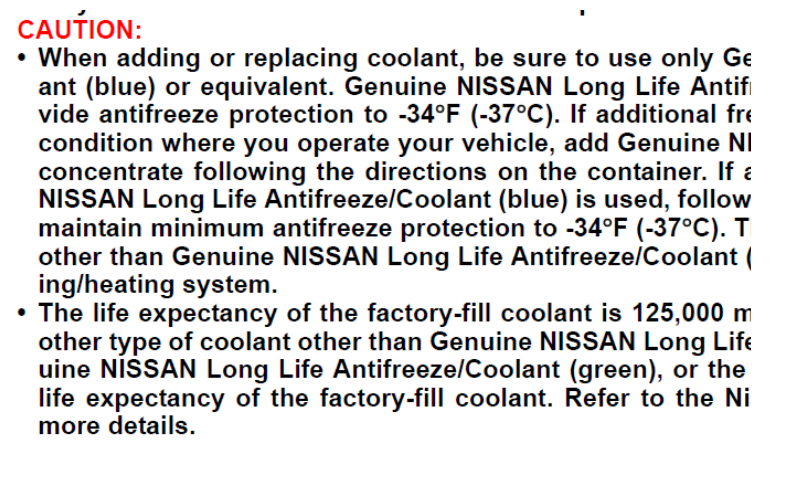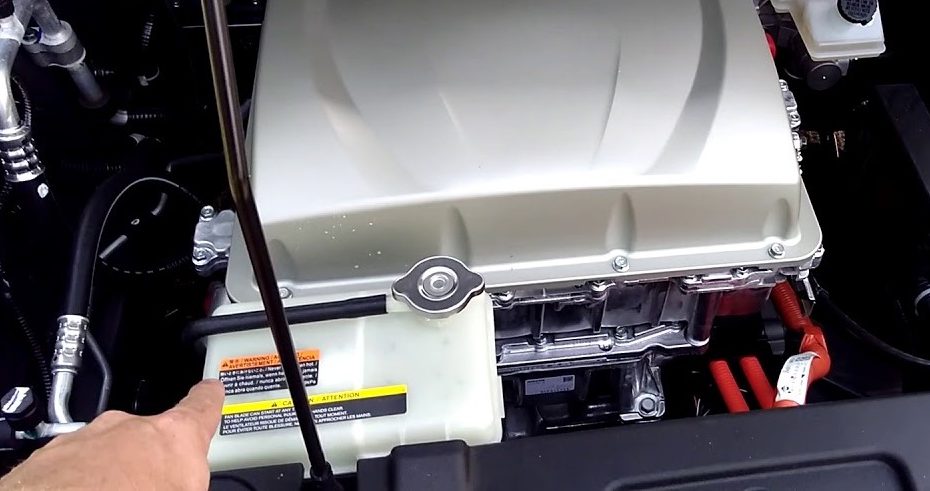The original coolant that comes in the leaf from Nissan is a silicate-free 50% water to 50% ethylene
glycol-based premixed solution. according to the technical manual of the 2013 leaf, it is recommended to replace the original coolant after 15 years or 200,000kms; whichever comes first. however, it is a good idea to check the state of the coolant once every year or so because the effectiveness of the coolant may be reduced due to various reasons.
The Cooling system
The cooling system in the leaf is quite similar in principle to an internal combustion engine’s cooling
system. The main difference is that the leaf’s cooling system lacks a traditional thermostat and
operates in a lower temperature range than an i.c.e. vehicle. instead of cooling an engine block, it cools the integrated unit which houses the on‐board charger, dc‐dc converter, motor’s inverter, and
motor. the coolant runs through the housing of those parts to collect heat and comes back to a fanned
radiator to dissipate the collected heat out to the environment, and the cycle continues due to the
water pump being activated/controlled by the car’s computer.
Due to the similarity in function, the maintenance needed to keep the leaf’s cooling system in check is
no different than to a regular vehicle.
Changing Coolant
Here is the REFILLING procedure of Nissan
CAUTION:
- • Do not reuse O-rings.
- • Do not put additive such as waterleak preventive, since it may cause cooling waterway clogging.
- • When refilling use Genuine NISSAN Long Life Antifreeze/Coolant (blue) or equivalent in its quality mixed with water (distilled or demineralized).
1. Install reservoir tank if removed and radiator drain plug.
CAUTION: Be sure to clean drain plug and install with new O-ring.
2. Check that each hose clamp has been firmly tightened.
3. Refill reservoir tank to “MAX” level line with engine coolant.
4. Install reservoir tank cap.
5. Set the vehicle to READY and operate the electric water pump.
6. If reservoir tank fluid level drops, set the vehicle in READY OFF state and fill with coolant to the “MAX” line of the reservoir tank.
7. Repeat from Step 4 to 7 until the reservoir tank fluid level stops dropping.
8. Operate the electrically-controlled water pump for approximately 10 minutes with the vehicle set in
READY state, and check that the reservoir tank fluid level does not drop.
9. If reservoir tank fluid level drops, repeat from Step 4 to 7.
CHECK WATER FLOW SOUND
CAUTION: Prior to check, be sure to close windows, doors, and hood, and turn off audio system and other electrical loads.
1. Set the vehicle to READY and operate the electric water pump.
2. Operate the electric water pump for 1 minute.
3. Check if water flow sound can be heard from the back of the compartment (near the onboard charger).
4. If water flow sound is heard, operate the electric water pump until it cannot be heard.
5. When the water flow sound cannot be heard, fill the reservoir tank up to the “MAX” line.
CAUTION: Insufficient coolant may cause low power or stop the vehicle due to insufficient cooling of the traction motor inverter. Be sure to bleed air thoroughly.
• Never operate the electric water pump without coolant.
That’s what Nissan said, lets look at the local scenarios.
Maintaining ratio
Pure water is the best heat transfer agent. water has a higher “specific heat capacity” than of pure
antifreeze. but water freezes at 0° Celsius and boils at 100° celsius. also, water causes corrosion inside the cooling system. to overcome the said shortcomings of water, antifreeze is added to water in order to lower the freezing‐point, increase boiling‐point, prevent corrosion and also to provide lubrication.
The downside to adding antifreeze to water is, the “specific heat capacity” of the coolant mixture gets
lowered and the viscosity of the liquid is also increased compared to pure water. the higher the amount of antifreeze in the mix, the harder the water pump has to work to collect and expel the heat
generated by the car. therefore, wasting energy and reducing the overall efficiency of the system. Even in the coldest of climates, the maximum amount of antifreeze in the mix should not exceed 70%
according to most antifreeze manufacturers and experts.
For an all‐year round hot climate like ours where freezing is not applicable, we can safely go as low as 25% antifreeze and 75% water. The boiling point for a mix of 30% antifreeze and 70% water would be around 105° celsius according to the sources listed below. it should never get that hot in a leaf unless there is some kind of fault in the system such as failure of the radiator fans, water pump malfunction, etc. in which case the car’s computer will shut down the car if detected.
However, if you’d like your coolant mixture to be as close to the original factory ratio, it is
recommended that you stick to the nissan recommended “all‐weather” ratio of 50% antifreeze and 50% water which would provide boiling protection of up to about 107° celsius.
Checking the status of your coolant when checking the status of your current coolant mix, the difficulty is in accurately determining the current ratio of antifreeze‐to‐water; even though several methods exist to measure the composition of a mixture. most tend to give varying results depending on variables like ambient temperature, quality of devices, the accuracy of charts/ formulae, etc.
The most foolproof way imaginable is to first get a sample of brand new 50/50 nissan blue coolant and get a target level using either a refractometer or a hydrometer. by using that level as our goal, we can test our current coolant mixture using the same device and check whether we need to add more
antifreeze or water to bring our mixture to the intended level.
However, please be noted that instruments such as refractometers and hydrometers only indicate the “specific gravity (https://en.wikipedia.org/wiki/Specific_gravity) ” of the mix. it cannot tell us the exact ratio of antifreeze: water of the mixture, nor can it tell us whether the antifreeze/anti‐corrosive chemicals in the mix have degraded or not.
Most hydrometers and refractometers will show between ‐35° to ‐30° celsius as the freezing point
reading for coolant mixed at the 50/50 ratio. if your current freezing point reading falls within that
range, we can assume that your coolant mixture is still close to the original. but as previously
mentioned, the freezing‐point reading (which is an approximation from specific gravity) is not a good
measurement of the effectiveness of your coolant.
If your original Nissan coolant is near its end of life (200k or 15yrs) or if you’re unsure what the previous owner of the car has done to the coolant; you should just skip checking the state of your coolant and completely flush out the system and replace with brand new Nissan blue coolant or any other good brand silicate free coolant mixed to the desired ratio.
Flushing Procedure
In the leaf, when the radiator and reservoir tank is drained, it takes about 3 liters of new fluid to fill it
back up to full level. but the total capacity of the leaf cooling system is 5.3 liters according to the
manual. what that means is about 2 liters of old coolant mix was still inside the system. so keep in mind that if you simply drain and refill the radiator/reservoir, it would not be a 100% true flush of the
system.
Due to the above-mentioned complication, if someone wants a true coolant flush, the recommended
the procedure is to:
- Shut down the car.
- Drain coolant by removing the radiator drain plug.
- Close drain plug and fill with de‐ionized distilled water.
- Turn the car on (with a/c running) and let the water pump cycle the water for a minute or two.
- Stop the car and drain again and repeat the above steps until all colored coolant has left the system and only clean distilled water remains.
- Then drain about 2.5 liters of distilled water and add 2.5 liters of 100% concentrate Nissan blue or
equivalent silicate-free antifreeze. - Turn the car back on and let it cycle for a few more minutes to bleed out air and add distilled water if the level drops doing the above procedure will guarantee a ratio close to 50/50 which you can verify by doing the math ( 2.5 / 5.3 x 100 = 47% ).
- Please refer to the correct year manual and find the full capacity of your cooling system, and then re‐do the math.
Note 1: only use deionized distilled water when mixing with coolant. never use tap water.
Note 2: it would be unwise to mix different brands if/when topping up antifreeze (i.e. when not doing a true flush). if unable to find Nissan blue or unsure what brand coolant is already in your system, it would be better to do a true flush and replace it with brand new antifreeze as per the above procedure.

Additional resources:
a video that demonstrates checking the ph balance of coolant using test strips and checking freeze‐
point using a refractometer: https://www.youtube.com/watch?v=5OC9nM0Frb4
(https://www.youtube.com/watch?v=5OC9nM0Frb4)
a video that shows how to use a hydrometer to check the freeze‐point of coolant and use a
voltmeter to check electrical conductance: https://www.youtube.com/watch?v=xVHRpBn‐yaA
(https://www.youtube.com/watch?v=xVHRpBn‐yaA)
freezing‐point, boiling‐point, specific heat, etc. charts for coolant mixtures:
http://www.engineeringtoolbox.com/ethyl … d_146.html
(http://www.engineeringtoolbox.com/ethylene‐glycol‐d_146.html)
disclaimer:
none of the information presented here is my own opinion and can be verified by anyone by searching the internet and/or talking to industry experts.
This article has been published with the permission of the author, Ryan Gunner.
